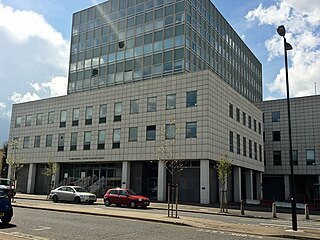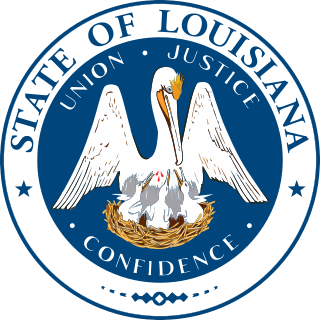Related Research Articles
In the United States, a state court has jurisdiction over disputes with some connection to a U.S. state. State courts handle the vast majority of civil and criminal cases in the United States; the United States federal courts are far smaller in terms of both personnel and caseload, and handle different types of cases. States often provide their trial courts with general jurisdiction and state trial courts regularly have concurrent jurisdiction with federal courts. Federal courts are courts of limited jurisdiction and their subject-matter jurisdiction arises only under federal law.

In the United States, a district attorney (DA), county attorney, county prosecutor, state's attorney, prosecuting attorney, commonwealth's attorney, state attorney or solicitor is the chief prosecutor or chief law enforcement officer representing a U.S. state in a local government area, typically a county or a group of counties. The exact and scope of the office varies by state. Generally, the prosecutor represents the people of the jurisdiction. With the exception of three states, district attorneys are elected, unlike similar roles in other common law jurisdictions.
The Alaska Court System is the unified, centrally administered, and totally state-funded judicial system for the state of Alaska. The Alaska District Courts are the primary misdemeanor trial courts, the Alaska Superior Courts are the primary felony trial courts, and the Alaska Supreme Court and the Alaska Court of Appeals are the primary appellate courts. The chief justice of the Alaska Supreme Court is the administrative head of the Alaska Court System.

The Criminal Court of the City of New York is a court of the State Unified Court System in New York City that handles misdemeanors and lesser offenses, and also conducts arraignments and preliminary hearings in felony cases.

A juvenile court, also known as young offender's court or children's court, is a tribunal having special authority to pass judgements for crimes that are committed by children who have not attained the age of majority. In most modern legal systems, children who commit a crime are treated differently from legal adults that have committed the same offense.
A teen court is a problem-solving court within the juvenile justice system where teens charged with certain types of offenses can be sentenced by a jury of same-aged peers. Their purpose is to provide an alternative disposition for juveniles who have committed a delinquent act, have committed a minor offense, or have been charged with a misdemeanor, and are otherwise eligible for diversion. Depending on their training, community support, and agreements with traditional court systems, most teen or youth courts are recognized as valid, legal venues for the process of hearing cases, sentencing and sentence fulfillment. Teen courts and their verdicts are not authorized by public law.
The Judiciary of Colorado is established and authorized by Article VI of the Colorado Constitution as well as the law of Colorado. The various courts include the Colorado Supreme Court, Colorado Court of Appeals, Colorado district courts, Colorado county courts, Colorado water courts, and municipal courts. The administration of the state judicial system is the responsibility of the Chief Justice of the Colorado Supreme Court as its executive head and is assisted by several other commissions. In Denver, the county and municipal courts are integrated and administratively separate from the state court system.
The government of New Mexico is the governmental structure of the state of New Mexico as established by the Constitution of New Mexico. The executive is composed of the governor, several other statewide elected officials and the governor's cabinet. The New Mexico Legislature consists of the House of Representatives and Senate. The judiciary is composed of the New Mexico Supreme Court and lower courts. There is also local government, consisting of county administrations, city governments, and special districts.

The Judiciary of New York is the judicial branch of the Government of New York, comprising all the courts of the State of New York.
In the Nevada state court system, the Nevada District Courts are the trial courts of general jurisdiction, where criminal, civil, family, and juvenile matters are generally resolved through arbitration, mediation, and bench or jury trials.
The Unified Judicial System of Pennsylvania is the unified state court system of the Commonwealth of Pennsylvania.
The Judiciary of American Samoa is defined under the Constitution of American Samoa and the American Samoa Code. It consists of the High Court of American Samoa, a District Court, and village courts, all under the administration and supervision of the Chief Justice. The High Court and District Court are both located in Fagatogo. The Chief Justice and the Associate Justice of the High Court are appointed by the United States Secretary of the Interior. Associate judges of the High Court, who may also serve in the village courts, and judges of the District Court are appointed by the Governor of American Samoa upon the recommendation of the Chief Justice and confirmed by the Senate.
The Judiciary of California or the Judicial Branch of California is defined under the California Constitution as holding the judicial power of the state of California which is vested in the Supreme Court, the Courts of Appeal and the Superior Courts. The judiciary has a hierarchical structure with the California Supreme Court at the top, California Courts of Appeal as the primary appellate courts, and the California Superior Courts as the primary trial courts.
The Florida State Courts System is the unified state court system of Florida.
The Judiciary of Virginia is defined under the Constitution and law of Virginia and is composed of the Supreme Court of Virginia and subordinate courts, including the Court of Appeals, the Circuit Courts, and the General District Courts. Its administration is headed by the Chief Justice of the Supreme Court, the Judicial Council, the Committee on District Courts, the Judicial Conferences, the Judicial Inquiry and Review Commission, and various other offices and officers.

The Judiciary of Louisiana is defined under the Constitution and law of Louisiana and is composed of the Louisiana Supreme Court, the Louisiana Circuit Courts of Appeal, the District Courts, the Justice of the Peace Courts, the Mayor's Courts, the City Courts, and the Parish Courts. The Chief Justice of the Louisiana Supreme Court is the chief administrator of the judiciary, and its administration is aided by the Judiciary Commission of Louisiana, the Louisiana Attorney Disciplinary Board, and the Judicial Council of the Supreme Court of Louisiana.
The judiciary of Ohio is the branch of the government of Ohio that interprets and applies the law of Ohio, ensures equal justice under law, and provides a mechanism for dispute resolution. The court of last resort is the Ohio Supreme Court.

Montana District Courts are the state trial courts of general jurisdiction in the U.S. state of Montana. Montana District Courts have original jurisdiction over most civil cases, civil actions involving monetary claims against the state, criminal felony cases, naturalization proceedings, probate cases, and most writs. They may also hear certain special actions and proceedings, and oversee a narrowly-defined class of ballot issues. Montana District Courts also have limited appellate jurisdiction regarding cases that arise in Justice Courts, City Courts, and Municipal Courts as well as Judicial review of decisions by state administrative law tribunals that fall under the Montana Administrative Procedures Act.
Inferior courts in Montana, also known as courts of limited jurisdiction, refer to those courts of law, established by the Constitution of Montana or authorized by law, with limited jurisdictions. These courts consist of City Courts, Justice Courts, and Municipal Courts. Inferior courts may be courts of record, or they may not. Appeals from inferior courts are made to Montana District Courts.
The Nevada Judiciary is the judicial branch of the Government of Nevada, which is responsible for applying the Constitution and law of Nevada. It consists of the Supreme Court, Court of Appeals, district courts, justice courts, and municipal courts. The Supreme Court oversees the administration of the judiciary.
References
- ↑ Montana Code Annotated, §41-5-101
- 1 2 3 4 State Bar of Montana 2010, p. 5.
- ↑ Montana Code Annotated, §41-5-201
- ↑ Montana Code Annotated §41-5-203
- ↑ Fischer 2015, pp. 4, 19.
- ↑ Van Ness & Strong 2015, pp. 43–54, 65–77.
- ↑ In re T.L.G. & M.E.H.,692P.2d1227(Mont.1984).
- 1 2 Elison & Snyder 2001, p. 145.